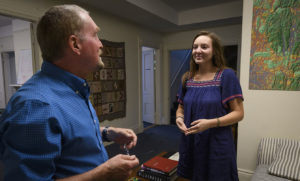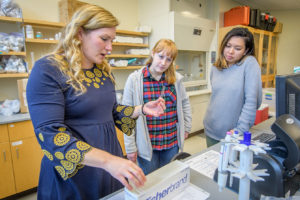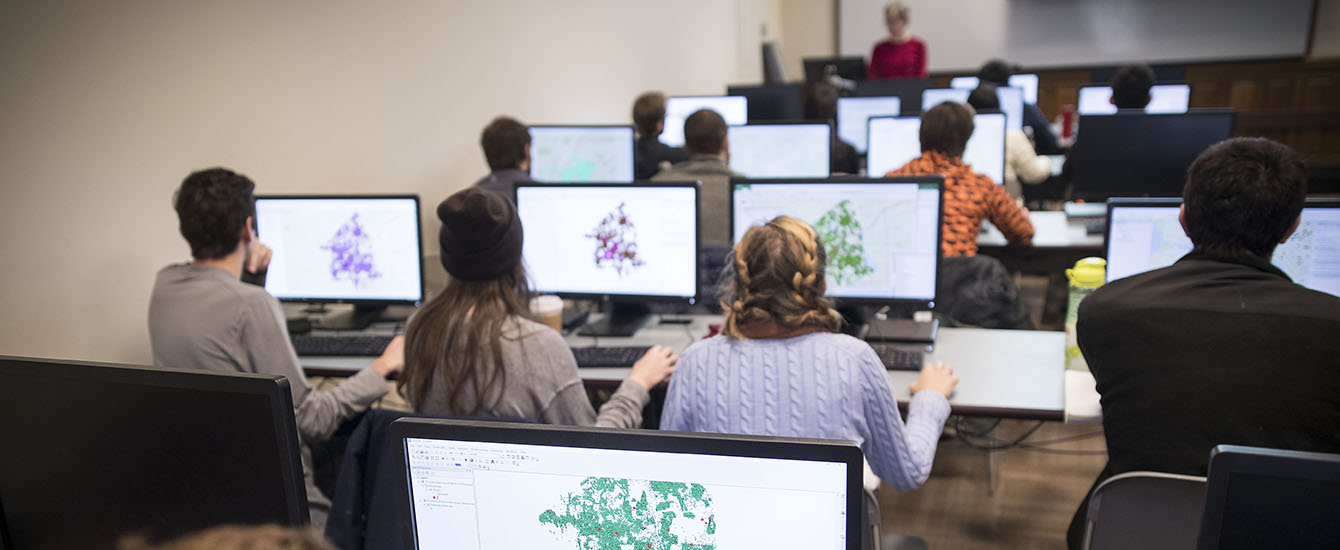Housed in the Jefferson Academic Center, the Graduate School of Geography maintains high-performance computing environments for teaching and research. Founded at the school and located across the street, Clark Center for Geospatial Analytics is a research center focused on the development of geographic information technologies, maintaining state-of-the-art computing and data facilities for software development and research applications.
Faculty members’ individual laboratories, which include a diverse range of field and lab equipment, are housed in Jefferson and the Sackler Science Center.
Agricultural Impacts Research Group
Professor Lyndon Estes’ Agricultural Impacts Research Group is equipped with two fixed-wing UAS: a Skywalker with thermal and visual and near-infrared imagers, and an RTK/PPK-capable Sensefly Ebee Plus with Sequoia+ multispectral camera. The group also has a suite of Arable Mark environmental sensors.
Biogeosciences Research Group
Professor Christopher A. Williams’ Biogeosciences Research Group is equipped with a wide array of micrometeorological and ecophysiological field equipment, including eddy flux and leaf gas exchange instrumentation; tools for measuring plant and soil properties, including portable leaf area and leaf area index meters; a handheld ASD field spectroradiometer; clinometers; meter tapes; handheld air and soil temperature and moisture sensors (Omega, Campbell Scientific); sling psychrometers; drying ovens and balances; soil corers; soil sieves; hydrometer bulbs, plus glassware for texture analysis; streamflow meters and waders; and soil augers. The Williams lab also has several many-processor desktops (≅100 CPUs) and a large volume of networked and desktop data storages.
Clark Center for Geospatial Analytics
 The Center for Geospatial Analytics at Clark University is a cross-disciplinary research and training hub focused on geographic information science, remote sensing, and spatial analysis. CGA supports cutting-edge research in areas such as artificial intelligence (AI), machine learning, geospatial modeling, and data visualization. The Center is equipped with its own dedicated services, high-performance computing infrastructure, and a full suite of geospatial software tools. Clark CGA enables collaboration across disciplines and departments, and regularly work with external scholars, government agencies, and industry partners. It also offers hands-on workshops, programs, and internship opportunities that apply geospatial methods to pressing environmental and societal challenges.
The Center for Geospatial Analytics at Clark University is a cross-disciplinary research and training hub focused on geographic information science, remote sensing, and spatial analysis. CGA supports cutting-edge research in areas such as artificial intelligence (AI), machine learning, geospatial modeling, and data visualization. The Center is equipped with its own dedicated services, high-performance computing infrastructure, and a full suite of geospatial software tools. Clark CGA enables collaboration across disciplines and departments, and regularly work with external scholars, government agencies, and industry partners. It also offers hands-on workshops, programs, and internship opportunities that apply geospatial methods to pressing environmental and societal challenges.
Landscape Monitoring Research Group
The Landscape Monitoring Research Group, led by Professor John Rogan, is equipped with field instruments for use in forest health inventory, including densitometers, hypsometers, dbh tapes, and calipers. The lab also contains a suite of GPS receivers, HOBO temperature sensors, and quantum light meters. The lab serves as a long-term geospatial data repository for the Human-Environment Regional Observatory program and the Extractive Industries Research Group.
Earth Observation and Remote Sensing Lab
The Earth Observation and Remote Sensing (EORS) Lab provides computing and office space infrastructures for graduate students focused on earth system science, remote sensing, and geographic information science within the Graduate School of Geography.
Forest Ecology Lab
The Forest Ecology Lab, led by Dominik Kulakowski, is equipped with a suite of field and lab equipment that supports experimental and observational research on forest ecosystems. This includes equipment for field observations (including GPS units, forest canopy densitometers, near-surface light and temperature meters, and measuring tapes), dendroecological data collection and analysis (including increment borers, sanders, Velmex Tree Ring Measuring Systems, and a CDendro semi-autonomous dendroecological processing system), and analysis of spatial data (including ArcGIS and TerrSet Geospatial Monitoring and Modeling Software).
Polar Science Research Lab
 Led by Professor Karen Frey, the Polar Science Research Lab includes a wet lab facility located in the Lasry Center for Bioscience building and equipped to perform biogeochemical analyses on freshwater and seawater samples. In addition, the lab houses multiple pieces of equipment and supplies that are routinely transported to the Arctic for remote field campaigns.
Led by Professor Karen Frey, the Polar Science Research Lab includes a wet lab facility located in the Lasry Center for Bioscience building and equipped to perform biogeochemical analyses on freshwater and seawater samples. In addition, the lab houses multiple pieces of equipment and supplies that are routinely transported to the Arctic for remote field campaigns.
Equipment on campus includes an 18-megaohm clean water source, multiple freezers and refrigerators, fume hood, a drying oven, a muffle furnace, research computer, along with field observation equipment: pH/DO/temperature/conductivity meters, a Shimadzu UV-1800 UV-VIS spectrophotometer, a Turner Designs Trilogy Laboratory Fluorometer, analytical balances, glassware, Kemmerer water samplers, and a Biospherical Compact Optical Profiling System (including two profiling radiometers, a QCP-PAR sensor, and a surface reference radiometer with a large metal tripod).

